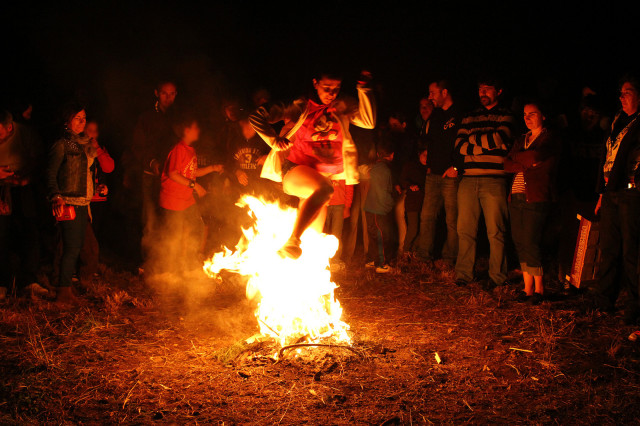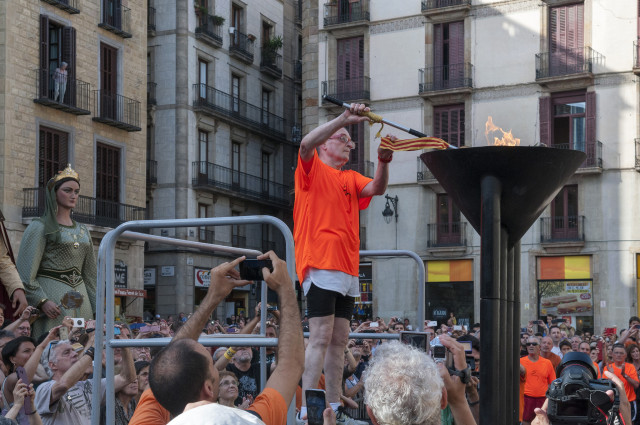 photo: Contando Estrelas
photo: Contando Estrelas
Observed especially in many of the world’s Catholic countries, the feast day of the Christian New Testament‘s St. John the Baptist is tomorrow, June 24th. But it’s today, St. John’s Eve, that folks in Latin America and Europe (and most especially Spain) make a big deal of, with celebrations, rituals, and superstitions that hark back to ancestral – even pre-Christian – times. Oh, and fire. Lots of fire.
Such traditions come into play on the Noche de San Juan because it correlates and often coincides with Midsummer, aka the June solstice – which was celebrated by Celts, Ango-Saxons, and other pre-Christians back to at least the ancient Romans, to mark the end of spring and the arrival of summer.
The night of June 23rd in Spain is celebrated with particular style and enthusiasm – revolving around hundreds of bonfires on beaches across the country, set to help participants rid themselves of evil spririts, as well as big, colourful street festivals in some big cities.
This celebration has always seemed to imbue the places where it’s held with a positive energy (even, some might say, a kind of mystical halo), especially noticeable in the country’s coastal communities. Ancient beliefs were blended with newer religious impulses to result in one of the most deep-seated customs in Spain.
After sundown, groups of friends generally head for the nearest beach, bringing food and drink to pass a convivial evening swapping stories and trying to rid themselves of the bad memories of the previous years. Several interesting rituales form part of this process:
- Bonfires are a central element here, meant to cleanse the bad and usher in a year of good luck. According to tradition, at the stroke of midnight you need to make a wish and jump over the bonfire up to seven or nine times (the number varies according to the region, but it’s always an odd number). In some places, in addition to wood, cloth effigies of popular figures are also burned.
- The sea is also an important factor during St. John’s Eve, as another ritual to get wishes granted is to jump backwards into seven (or, again, nine) waves as the new day arrives (some even take off their clothes to do this, but it depends on the individual). Some who are particularly superstitious believe that taking the plunge on this day will help boost a woman’s fertility.
- Back on the home front, some folks also stash a sprig of cedar under their pillows, along with a wish written on a piece of paper. After letting a candle burn all the way down, the next morning the paper is burned with the remaining wax, and the whole lot is buried, symbolising a planted seed of hope.
- Those particularly interested in staying beautiful throughout the coming year find a groundwater spring and rinse their faces in it at midnight. But they must have a care, because if they glance at a mirror before sunrise, this ritual will lose its power.
 photo: Omnium Cultural
photo: Omnium Cultural
Then, too, many are the Spanish towns and cities which pull out all the stops to celebrate – each with its own particular twist. In Málaga, for example, Malagueños commonly take advantage of St. John’s Eve bonfires and barbecues to grill and share with each other a typical local favourite, espetos de sardinas (sardine skewers).
Up in Galicia, this night is unthinkable without a queimada next to the ocean – a schnapps-based libation which is set on fire and comes with a dose of mysticism and even a dab of conjuring.
In Catalonia, where the relatively recent (1955) but already beloved tradition of lighting the Canigó Flame from the eponymous iconic mountain of the Pyrenees in various cities, including Barcelona – arriving at the Old Town’s Plaça Sant Jaume before continuing on the ignite bonfires in various neighbourhoods of the city.
Perhaps the best known celebration of all is the Fogueres de Sant Joan in the coastal city of Alicante, which ever since 1928 what’s set aflame have been huge, colourful, sometimes satirical and usually whimsical figures inspired by the falles celebration of Valencia.
But wherever you go in Spain to celebrate St. John’s Night, it’s a hunka hunka burning fun!

